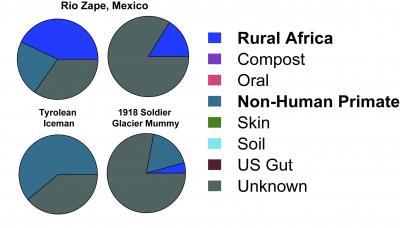Dead guts spill history of extinct microbes
Fecal samples from archeological sites reveal evolution of human gut microbes
Public Library of Science
Source - http://www.eurekalert.org/pub_releases/2012-12/plos-dgs120712.php

This shows microbiomes across time and populations.Credit: Tito RY, Knights D, Metcalf J, Obregon-Tito AJ, Cleeland L, et al. (2012) Insights from Characterizing Extinct Human Gut Microbiomes. PLoS ONE 7(12):e51146.doi:10.1371/journal.pone.0051146
Extinct microbes in fecal samples from archaeological sites across the world resemble those found in present-day rural African communities more than they resemble the microbes found in the gut of cosmopolitan US adults, according to research published December 12 in the open access journal PLOS ONE by Cecil Lewis and colleagues from the University of Oklahoma.
The researchers analyzed 1400-8000-year-old fecal samples preserved at three archaeological sites: natural mummies from Caserones in northern Chile, and samples from Hinds Cave in the southern US and Rio Zape in northern Mexico. They also used samples from Otzi the Iceman and a soldier frozen on a glacier for nearly a century. They compared the now-extinct microbes in these samples to microbes present in current-day soil and compost, as well as the microbes present in mouths, gut and skin of people in rural African communities and cosmopolitan US adults.
The authors discovered that the extinct human microbes from natural mummies closely resembled compost samples, while one sample from Mexico was found to match that from a rural African child. Overall, the extinct microbial communities were more similar to those from present rural populations than those from cosmopolitan ones. The study concludes, "These results suggest that the modern cosmopolitan lifestyle resulted in a dramatic change to the human gut microbiome."
As Lewis explains, "It is becoming accepted that modern aseptic and antibiotic practices, are often beneficial but come with a price, such as compromising the natural development of our immune system through changing the relationship we had with microbes ancestrally. What is unclear is what that ancestral state looked like. This paper demonstrates that we can use ancient human biological samples to learn about these ancestral relationships, despite the challenges of subsequent events like degradation and contamination."
Citation: Tito RY, Knights D, Metcalf J, Obregon-Tito AJ, Cleeland L, et al. (2012) Insights from Characterizing Extinct Human Gut Microbiomes. PLoS ONE 7(12):e51146.doi:10.1371/journal.pone.0051146